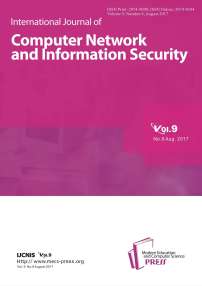Cover page and Table of Contents. vol. 9 No. 8, 2017, IJCNIS
Бесплатный доступ
ID: 15010007 Короткий адрес: https://sciup.org/15010007
Статьи выпуска 8, 2017 International Journal of Computer Network and Information Security(IJCNIS)
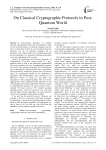
On Classical Cryptographic Protocols in Post-Quantum World
Статья научная
In post-quantum approach, we consider classical (non-quantum) protocols and primitives which are run by honest parties on classical computers and our aim is to keep their security in an environment where the adversary can rely on quantum computers [3]. In particular, even a harder goal is set by requiring provable security guaranties in a concurrent running environment as we aim computational UC-security. Unruh [16] conjectured that classical arguments of computational UC-security remain usable in a post-quantum world as long as the underlying computational UC-secure primitives are also computationally quantum UC-secure. Our proposed technique (full factorization) aims at reducing the original protocol into a statistically-secure protocol by turning the protocol into a hybrid one where all cryptographic primitives are substituted by appropriate ideal functionalities. The considered set of primitives consists of secret key and public key encryption as well as digital signature. This way and by applying the Unruh's Quantum Lifting Theorem as well as the Quantum Universal Composition Theorem we gain a computationally quantum UC-secure protocol from a classical UC-secure protocol. We consider quantum standard-security, where the adversary can send only classical inputs to honest algorithms, i.e. honest machines cannot receive quantum superposition of inputs If we add also the practical need of efficiency our example is the class of protocols built from symmetric key primitives. A practical (fast) implementation could be based on AES encryption algorithm with appropriate key size as long as we live with the wide belief that this algorithm is secure against a quantum adversary.
Бесплатно
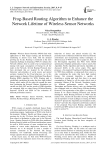
Frog-Based Routing Algorithm to Enhance the Network Lifetime of Wireless Sensor Networks
Статья научная
Wireless Sensor Networks (WSN) finds wide applications in both Target tracking and Environment monitoring in almost every field, with the demand growing day by day. Routing is considered as the most important challenge in designing a WSN. To enhance the Network Lifetime, there is a need to have a balanced load sharing with equal consumption of Energy by all the nodes in the Network. Several Routing Protocols have been developed that are inspired by the collective behaviour and principles of social insects and animal societies. Inspired by the Frog behaviour, we in this paper propose an Energy efficient distributed Frog-Based Routing (FBR) algorithm for WSN. Routing path is established considering the nodes that have high residual Energy which makes all the nodes die around the same time, prolonging the Network Lifetime. Simulation was carried out using NS2 and the results of FBR algorithm are compared with two other Energy Efficient Routing Protocols LEACH and SPIN for the evaluation of different performance metrics.
Бесплатно
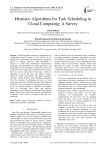
Heuristic Algorithms for Task Scheduling in Cloud Computing: A Survey
Статья научная
Cloud computing became so important due to virtualization and IT systems in this decade. It has introduced as a distributed and heterogeneous computing pattern to sharing resources. Task Scheduling is necessary to make high performance heterogeneous computing. The optimization of related parameters, and using heuristic and meta-heuristic algorithms can lead to a reduction of the search space complexity and execution time. So, several studies have tried using a variety of algorithms to solve this issue and improve relative efficiency in their environments. This paper considered examines existing heuristic task scheduling algorithms. First, the concepts of scheduling, the layer of cloud computing, especially scheduling concept in the SaaS and PaaS layer, the main limits for improving the quality of service, evaluation methods of algorithms and applied tools for evaluating these ideas and practical experimental used methods were discussed and compared. Finally, future works in this area were also concluded and a summary of this article is presented in the form of a mind map.
Бесплатно
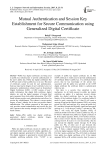
Статья научная
Public–key digital certificates are being used in public key infrastructure to provide authentication of the user's public key. Public key digital certificates like X.509 are used to bind a public key to its user. This kind of certificates cannot be used for user authentication. Such use may lead to forgery of user's identity. Lein et al proposed a authentication scheme based on Generalized Digital Certificates (GDC). A GDC consists of user's public information like digital birth certificate, digital identity, etc. and the digital signature of trusted third party generated from that public information. The GDC based scheme provides user authentication and allows for session key establishment. The scheme is secure against forgery of user's identity but it does not provide mutual authentication. The scheme proposed in this paper not only provides mutual authentication and session key but also it preserves the security strength of Lein et al's GDC based scheme.
Бесплатно

Location Privacy using Homomorphic Encryption over Cloud
Статья научная
Homomorphism is a concept that allows one to perform arbitrary calculations on the cipher text. One of the application of this concept is securing one's location while one uses location based services(LBS). In this paper I have discussed an approach to preserve mobile user's location while accessing some location based service. The mobile user is trying to find the nearest locations of his interest using a mobile application. While doing so he wishes to keep his location coordinates a secret from the server. This is because, these days since servers may be maintained by a third party or a middleware might be involved. There is no scope of trusting anyone in this insecure world. Therefore, since in homomorphic encryption offers a way of making calculations on the cipher text thereby not revealing anything about the plaintext to the server, it becomes a more secure and safer choice for making a system which wants to keep the data protected from the server. Problem Statement: Implementing k-nearest neighbour algorithm while preserving user location privacy using homomorphic encryption.
Бесплатно
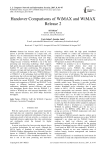
Handover Comparisons of WiMAX and WiMAX Release 2
Статья научная
Internet has become major need of every person. It provides information in a single click, cost effective way of communication with the outside world, gigantic library, social networking, feeds and blogs, satellite TV and business. World has become a global village because of internet. WiMAX is one of the most promising and innovating technology which supports high speed data and multimedia applications like VoIP, Satellite TV and video conferencing. The demand for enlarged coverage and high speed internet made WiMAX services still inadequate to the users. WiMAX Release 2 or WiMAX 2 is 4G technology built on IEEE 802.16m specification that will provide high bandwidth for VoIP and peak download rate up to 300Mbps which is more than double the current WiMAX . This work enlightens features and comparison of WiMAX and WiMAX 2 with respect to different handover schemes, network architecture, bandwidth, spectral efficiency and sector size throughput. Result shows that the WiMAX 2 is similar to WiMAX but with increased bandwidth, 4.5% better spectral efficiency and 28/54 Mbps Sector/site throughput.
Бесплатно
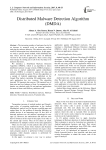
Distributed Malware Detection Algorithm (DMDA)
Статья научная
The increasing number of malwares has led to an increase in research work on malware analysis studying the malware behavior. The malware tries to leak sensitive information from infected devices. In this paper, we study a specific attack method, which distributes the data source and the point of data loss on different versions of the malware application. That is done using local storage by storing part or all of the vital data to be leaked in the future. We introduce a Distributed Malware Detection Algorithm (DMDA), which is an algorithm to detect distributed malware on app versions. DMDA proposes a new way to analyze application against redistributed malware. DMDA is created to analyze the data and identify transitional loss points. We test this algorithm on a sample of Android applications published on the Google Play market containing 100 applications, where each application has two versions. The algorithm detected 150 transient data sources, 200 transient loss of data point and two leakages of data. In comparison, this dataset was checked using 56 anti-malware applications but none of them could find any malicious code.
Бесплатно

